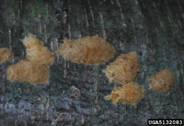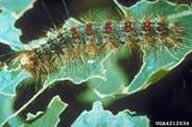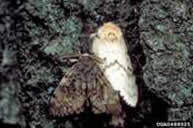In March 2022, the Entomological Society of America adopted the common name “spongy moth” as the common name for the invasive moth Lymantria dispar (formerly known as “gypsy moth”). We will be working toward changing this name in our publications and on our website. Find more information about this name change.
Spongy moth (formerly gypsy moth) is a serious forest pest capable of causing severe damage to hardwood trees, especially oaks. This damage is inflicted as the spongy moth larvae defoliate entire stands of trees. In cooperation with the USDA and the USFS, Georgia deploys traps across the state every year to detect the presence of the moth. Although the threat is always present, there are no known infestations currently in Georgia.
History of Spread

Spongy moths were brought into Massachusetts in the late 1800’s with the intent to farm the moths for the silk produced by the larvae. It wasn’t long before the moths escaped captivity and moved out into the surrounding woodlands. The spongy moth is now considered naturalized in many northeastern states. While Georgia has had outbreaks in the past, these spots were eradicated by state and federal forestry officials. It is likely that these outbreaks were started by individuals moving cargo with egg masses attached to it from infested areas. The natural spread of spongy moths occurs as newly hatched larvae spin long silk threads and ride on the breeze. There are no known infestations of spongy moths in Georgia.
Identification & Life Cycle

The spongy moth goes through four stages of development – egg, larvae, pupae, and moth. In summer, a moth lays up to 1000 eggs in masses between the size of a dime and a quarter. The eggs are covered in the buff-colored hairs the female pulls from her abdomen (Figure 1). The female will lay eggs on most anything but usually does so in a protected area. In the south, egg hatch will begin in late March. Spongy moth larvae are very easy to distinguish when they are about half grown. The larvae have 5 pairs of blue dots and 6 pairs of red dots down their back (Figure 2). The larvae will enter the pupal stage in May. Adult moths will emerge 10-14 days later. The moth is not very distinguishable. The larger female is a brown buff color. The male is darker and smaller (Figure 3). Male moths fly off in search of female mates. The female European spongy moth does not fly but the female Asian spongy moth does.
Damage Caused

The larvae, or caterpillar, is the destructive stage of the spongy moth. These larvae feed on several hundred different trees species, especially oaks. During epidemic population levels entire forests can be stripped of their leaves (or defoliated). Repeated, severe defoliation from spongy moth larvae in combination with other environmental stressors including drought, temperature fluctuations, hurricanes/tornadoes, and wildfires can result in tree death. The impact of spongy moths is felt by timber growers, wildfire managers and homeowners alike.
________________________________________________________________________________________________________________________
Contact Us
We are happy to assist with any questions or concerns you may have. If you can’t find something you are looking for, please let us know, and we will be glad to help.
Ask a Forest Health Specialist